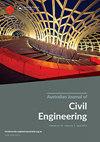Shear behaviour of concrete wide beams with spiral lateral reinforcement
IF 1.6
Q3 ENGINEERING, CIVIL
引用次数: 5
Abstract
ABSTRACT Wide beams are commonly used in reinforced concrete (RC) structures for architectural considerations such as facilitating the placement of services and providing adequate clear height. However, behaviour of these beams is not as efficient as normal width beams due to the small structural depth. Motivated by the lack of guidelines for wide RC beams with spiral reinforcement, this paper investigates their shear behaviour using innovative lateral reinforcement configurations. A comprehensive experimental program was conducted by testing nine beams under four-point loading. The effect of different parameters on the behaviour of such beams was investigated. These parameters included number, dimensions, and configurations of spirals. The experimental program also included testing of 18 standard cylinders spirally reinforced under compression to study the performance of confined concrete in the compression zone of wide beams. The results showed that the spiral lateral reinforcement is an efficient alternative for traditional closed stirrups for shear resistance in wide beams. Compared to regular closed stirrups, using spiral reinforcement or inclined links with regular closed stirrups can greatly improve the shear capacity and deformation. Also, reduction in the amount of lateral reinforcement can be achieved if the proposed lateral reinforcement is adopted instead of traditional stirrups. Based on the test results and the ACI 318–19 code, an equation is proposed and validated to estimate the shear strength of wide beams with regular/spiral lateral reinforcement.螺旋侧配筋混凝土宽梁的抗剪性能
宽梁通常用于钢筋混凝土(RC)结构,以方便设施的安置和提供足够的净高度。然而,由于结构深度小,这些梁的性能不如正常宽度梁有效。由于缺乏螺旋钢筋宽钢筋混凝土梁的指导方针,本文利用创新的横向钢筋配置研究了它们的剪切行为。通过对9根梁在四点荷载作用下的试验,进行了全面的试验方案。研究了不同参数对此类梁性能的影响。这些参数包括螺旋的数量、尺寸和结构。实验程序还包括18个标准螺旋增强圆柱体在压缩下的测试,以研究宽梁受压区约束混凝土的性能。结果表明,螺旋侧箍筋是一种有效的替代传统封闭箍筋的宽梁抗剪能力。与常规封闭箍筋相比,采用螺旋配筋或斜杆与规则封闭箍筋可以大大提高抗剪能力和变形能力。此外,如果采用拟议的侧向加固而不是传统的马镫,则可以减少侧向加固的数量。根据试验结果和ACI 318-19规范,提出了规则/螺旋配筋宽梁抗剪强度的计算公式,并进行了验证。
本文章由计算机程序翻译,如有差异,请以英文原文为准。
求助全文
约1分钟内获得全文
求助全文

 求助内容:
求助内容: 应助结果提醒方式:
应助结果提醒方式:


